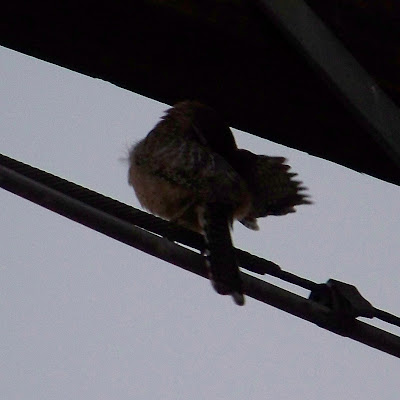Red Phalarope--despite being listed as "very rare" for October, this guy posed for every birder there. Very cool.
American Avocet--LOVE.THEM.
Least Sandpiper--these are supposed to be abundant during October at HBBR; true to advertising, two flocks of 50 or more were in the drying areas, along with other sandpipers mixed in--but IDing the others was way too tough for me. Someone else ID'd these guys for me first.)
American White Pelican--two of them were lounging on the water like swans! They were beautiful.
Crested Caracara--these birds are AWESOME, a much anticipated lifer--they look like the kind of scary bird that would eat your eyes out in a horror movie.
White-faced Ibis--these were supposed to be plentiful as well, but I only saw one--he looked almost like a Glossy Ibis, but they're supposed to be rare here right now, so I felt confident calling this one a White-faced in winter plumage. I thought I'd gotten a photo, but I think Mary's the one who got it.
Least Grebe--I didn't see any Eared Grebes although the web site site they'd be common; I did, however, see this tiny little grebe, along with some other birds listed as "uncommon" during Octobers past, like the White Pelicans and the Crested Caracaras.
Loggerhead Shrike--wish this one had been closer; I was glad I at least had the scope to watch him for a bit in the distance; a birding guide who was leading a trip pointed him out to us.
Ruddy Duck--they're working hard to become my favorite duck because of their sassiness, but being in winter plumage didn't help them knock Wood Duck out of the top spot.
Killdeer--it was like being back in PA, listening to these guys calling constantly.
Scissor-tailed Flycatcher
Turkey Vulture
Eastern Phoebe
Belted Kingfisher
Blue Jay
American Crow
Cattle Egret
Carolina Wren
Double-crested Cormorant
Great Egret
Blue-winged Teal
Green-winged Teal
Northern Shoveler
American Coot
Red-winged Blackbird
Red-tailed Hawk
American Kestrel
Northern Cardinal
Mourning Dove
European Starling
Common Grackle
I saw a few unidentifiable birds too: some generic sandpiper/peeps that were mixed in with the tiny Least Sandpipers; a flycatcher of some sort (not vocalizing, so no chance of an ID from me); a warbler that might have been a Nashville, but I just didn't get a good enough look to make sure (people were saying there was one around); and one bird that looked like a small wren but had a crazy call that was unlike any wren I know of -- I haven't been able to ID him at all, but I do have a short video of his call so I'm still working on it.
HBBR is quite a place, with three huge ponds full of ducks and other birds, a wooded trail that has several cuts to the Colorado River and some good viewing outlooks, and a marshy area in one of the big ponds. There are also a lot of open fields around the facility where we saw the caracaras and the shrike. Mary and some other birders saw a coyote but I didn't.
It was pretty wild to see that Red Phalarope, and I'm so glad I got such a long look at him.
There were many birds I didn't see that were supposed to be abundant or common during October. I didn't see any Eared Grebes, Swainson's Hawks, Wilson's Snipes, American Pipits, Lincoln's Sparrows, Western Meadowlarks, Black-bellied Whistling Ducks, or Lesser Scaups. I was bummed that I didn't see the whistling duck; those guys are supposed to be all over central and southern Texas.
Listed as fairly common among the sandpipers were Baird's and Stilt Sandpipers--I just couldn't summon the patience or the closer view to ID the bigger pipers wandering among the little Least Sandpipers though. I thought I saw a Long-billed Dowitcher but he vanished during my flipping through the guide to make sure. Wilson's Phalarope was also supposed to be there but wasn't; same for the Vesper Sparrow, Dickcissel, and Nashville Warbler (assuming I didn't see him that one time I mentioned above).
All in all, though, it was quite a day at the Reserve. My old friend Kris and I went back on Sunday but didn't stay long--we saw the avocets and some more caracaras, then we went for breakfast! Mary and I had spent all morning and all afternoon (with a short lunch break) there on Saturday, and I was just too tired to stay much longer than a couple of hours on Sunday. But we had a nice time; I hadn't seen Kris in years, and our friendship dates back to the early 1980s!
So my lifelist stands at 233, and I'm really looking forward to a quick weekend trip south. I really want to see some Green Jays and all the other RGV specialties. I might have to wait until spring, but even then it'll be a great trip. I might even get to see my old college town of Kingsville, my old hometown of Harlingen, and my birthplace of McAllen. It's funny; it feels like I've been away from Texas forever, even though it's only been seven years. But the old memories are still there, and my heart still swells with Texas pride when I think of bluebonnets, longhorn cattle, and huge open expanses of this state.







































